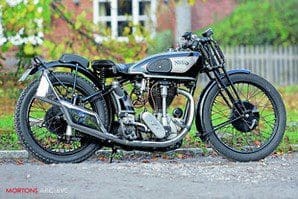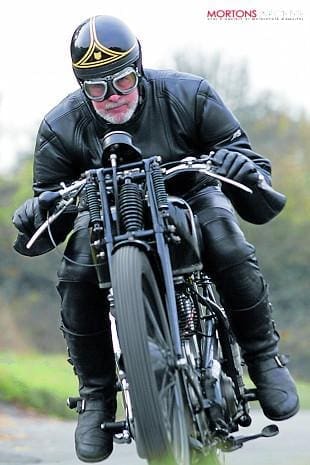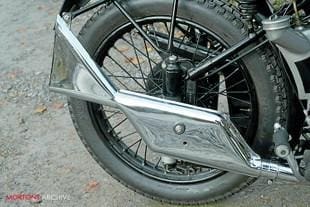
Years ago, I happened to see the famous actress Marlene Dietrich getting into a taxi in London, and to be absolutely frank, she looked to me like a rather plain and elderly little lady. I was obviously in a distinct minority, however, because the rapt expressions of the awestruck fans surrounding her showed she’d retained much of her star quality.
It’s a bit like that with overhead camshaft Nortons. A detached observer would have to admit their leak-prone motors didn’t expand the technological envelope too much, and they didn’t go much better than their overhead valve stablemates. With the notable exception of the Featherbed framed jobs from the 1950s, they didn’t even handle much better than other contemporary sporting motorcycles. And yet, like the ageing film star, any cammy Norton has that certain indefinable something.
 Magnetism, sex appeal, call it what you will, these machines indisputably have the ability to stop almost all classic motorcycle enthusiasts dead in their tracks, even if their personal enthusiasm is for much faster post-WWII big twins, or more sophisticated foreign lightweights. So I didn’t need asking twice to have a gallop on this 490cc Model 30 International belonging to Berkshire engineering project manager Howard Martin.
Magnetism, sex appeal, call it what you will, these machines indisputably have the ability to stop almost all classic motorcycle enthusiasts dead in their tracks, even if their personal enthusiasm is for much faster post-WWII big twins, or more sophisticated foreign lightweights. So I didn’t need asking twice to have a gallop on this 490cc Model 30 International belonging to Berkshire engineering project manager Howard Martin.
Howard was no stranger to fast bikes back in his youth, and particularly remembers a Bonneville-engined Gold Star, but family commitments and house moves resulted in a long lay off until about 1990 when he bought an OK Supreme project. Its rebuild was delayed because he moved house again, and also became side-tracked by the purchase and use of a vintage Dodge car, so when a friend asked him a couple of years ago if he was interested in buying the post-vintage Inter, which was already on the road, he naturally jumped at the chance.
“The gear selection isn’t very positive,” he warns me before I set off. “I checked the gearbox over, and I’ve fiddled with the selector mechanism several times, but it still has a mind of its own, especially on upward changes.” Well, it turns out he’s quite right, but forewarned is forearmed, and I’m not going to condemn an otherwise excellent motorcycle on that score. In any case, if I’d been more patient Howard would have had time to seek professional help before my ride, and I’m sure that the ‘Dolls Head’ gearbox – so nicknamed on account of the way the selector mechanism is tacked onto its top – will soon be returned to typically tough and reliable action.
False neutrals, and finding third gear when you expected second or top, would be a calamity on many motorcycles, but on a pre-WWII International, they are mere irritations. The heavily flywheeled motor has torque that would shame many a side-valve slogger, and if I can’t change down at the right time, I can always retard the ignition and plod away until I get things sorted out. The clutch helps, too, with a light and positive action. The thrust rod that separates the plates is actuated by a ‘quick thread’ that’s rather more sophisticated (and doubtless more costly to make) than the simple lever used later on, and it’s so effective, I know of at least one instance where a 1950s Norton/AMC gearbox has been retro-fitted with the older mechanism.
 Pre-war Internationals were, of course, primarily competition motorcycles that could also be used on the road, and it’s probable this one had actually been used on the track, because it came to Howard fitted with a close-ratio racing gearbox with no provision for a kickstart. The rear mudguard also carried a ‘bum pad’ that would suit a racer but would be too narrow and sloping to be of use to a pillion.
Pre-war Internationals were, of course, primarily competition motorcycles that could also be used on the road, and it’s probable this one had actually been used on the track, because it came to Howard fitted with a close-ratio racing gearbox with no provision for a kickstart. The rear mudguard also carried a ‘bum pad’ that would suit a racer but would be too narrow and sloping to be of use to a pillion.
Howard understandably didn’t wish to modify the original ‘box, so he bought the roadster one that is causing the current problems. And in turn, that meant getting another exhaust pipe, as the one already fitted would have obstructed the kickstart shaft. The kickstart lever – a Kempton autojumble find – curls so neatly round the right-hand footrest that it barely leaves room for my heel, but that’s considerably less inconvenient than having to do a run and jump start each time.
Rather remarkably, I find I can actually start the Inter on the kickstart, too, despite there being no valve lifter/decompressor. I just stand on the lever until the piston eases over top dead centre, put the magneto on half retard, give a hefty swing and am almost invariably rewarded by an impressive and reliable ‘tonk, tonk, tonk’ from the enormous ‘Brookland’s can’. And yes, both Howard and I know a 1939 Norton should have a conventional tubular silencer, but the can (I refuse to call it a silencer, as amplifier is a more accurate description) sounds superb and looks miles better than the original fitment, which was itself a tremendous improvement over the appallingly ugly double-barrelled job specified the previously.
 This easy-going nature is all the more remarkable because the Norton is fitted with the legendarily temperamental TT carburettor, so obviously things are set up correctly. And that includes the competition magneto, which bizarrely has a series of holes drilled in its supposedly waterproof cover. Discrepancies from standard spec – if there is such a thing for a production racer – are few and far between. At first sight the chainguard doesn’t appear to match the rear sprocket very well, but photographs of other pre-war Inters show a similar design, presumably adopted to promote easy wheel removal. And who knows if the saddle is original, but it’s certainly a period item, still wearing its Mansfield maker’s badge.
This easy-going nature is all the more remarkable because the Norton is fitted with the legendarily temperamental TT carburettor, so obviously things are set up correctly. And that includes the competition magneto, which bizarrely has a series of holes drilled in its supposedly waterproof cover. Discrepancies from standard spec – if there is such a thing for a production racer – are few and far between. At first sight the chainguard doesn’t appear to match the rear sprocket very well, but photographs of other pre-war Inters show a similar design, presumably adopted to promote easy wheel removal. And who knows if the saddle is original, but it’s certainly a period item, still wearing its Mansfield maker’s badge.
The Norton International is such an accepted – and revered – part of British motorcycling history it’s strange to think they had been in production for less than a decade when this model was made. The overhead camshaft range had started with the prosaically named CS1 (CamShaft One) designed by Walter Moore, which was instantly successful when launched in 1927. Moore’s defection to NSU – together with his engine design – led to a temporary blip in development, but Arthur Carroll’s redesign led to a new model (still called the CS1) in 1930, and all subsequent cammy Nortons are descended from that model.
 Ironically, it was the CS1’s successes on the international racing circuit during 1931 that led to it being demoted to the role of fast tourer; because the racing mantle was then taken over by the new Model 30 International. From then on, until its production stopped in 1939, the CS1 was definitely a poor relation that was usually updated a couple of years after improvements had appeared on the International. So, whereas the racer had a four-speed gearbox from the start, it was only given to the CS1 in 1933, the year the Inter’s front forks received the auxiliary side springs seen on Howard’s Model 30. These appeared on the CS1 in 1934, but war intervened before the 1938 option of plunger rear suspension could be passed on.
Ironically, it was the CS1’s successes on the international racing circuit during 1931 that led to it being demoted to the role of fast tourer; because the racing mantle was then taken over by the new Model 30 International. From then on, until its production stopped in 1939, the CS1 was definitely a poor relation that was usually updated a couple of years after improvements had appeared on the International. So, whereas the racer had a four-speed gearbox from the start, it was only given to the CS1 in 1933, the year the Inter’s front forks received the auxiliary side springs seen on Howard’s Model 30. These appeared on the CS1 in 1934, but war intervened before the 1938 option of plunger rear suspension could be passed on.
The consequence was that few CS1s were sold during the 1930s, as the ohv models – particularly the ES2 – were cheaper, almost as fast and received upgrades at the same time. The situation was mirrored in the 350cc class, with the CJ (Camshaft Junior) playing second fiddle to the Model 40 racer, and consequently being outsold by the road-going ohv Model 50. Incidentally, even when prepared purely for racing, Internationals should never be confused with Manx Nortons, as the latter title wasn’t officially used before WWII, and the postwar models were quite dissimilar. The misunderstanding apparently arose because a batch of Internationals prepared for the 1939 Manx Grand Prix was put into mothballs during WWII. By the time they reappeared they had become known as the Manx Internationals, whereupon the nickname was inherited by many of their predecessors.
‘Howard Martin’s 1939 Model 30 International is a rare machine, since it was made while the Bracebridge Street factory was gearing up for the mass-production of military motorcycles, and thousands of 16H side valvers were already pouring off the assembly lines’
Howard Martin’s 1939 Model 30 International is a rare machine, since it was made while the Bracebridge Street factory was gearing up for the mass-production of military motorcycles, and thousands of 16H side valvers were already pouring off the assembly lines. Unfortunately, its original owner is unknown, but it’s a safe bet he was well-known (and well-heeled) and/or he had influential friends. It was certainly a top spec machine, as it had the optional plunger rear suspension, but it wasn’t one of the special racers, as the oil filler neck is on the right-hand side, whereas theirs were positioned on the left to assist speedy pitstops.
Incidentally, the out and out racers had a forward facing rear stand, and as ideas go that must rank with the proverbial chocolate teapot. Certainly it was compact, and its design wasn’t complicated by the need to avoid tangling with the rear suspension, but the consequences of it dropping down at 100mph and jack-knifing the whole plot into the air are too dreadful to contemplate. No such concerns here, as Howard’s bike just has a prop stand that appears to have been pinched from a post-WWII Norton roadster.
 It also has the wonderful ‘pie-crust’ petrol tank, so named because of the way its bottom edge is castellated and fastened around the main body. At least it looks wonderful, but more than one restoration has literally come unstuck when supposedly specialist finishers have used heat to cure new paintwork, not realising that the parts are only soft-soldered together.
It also has the wonderful ‘pie-crust’ petrol tank, so named because of the way its bottom edge is castellated and fastened around the main body. At least it looks wonderful, but more than one restoration has literally come unstuck when supposedly specialist finishers have used heat to cure new paintwork, not realising that the parts are only soft-soldered together.
The best thing is Howard Martin’s Norton International goes as well as it looks. Once on the move, I could ignore the gearbox problems and just enjoy the ride. Norton’s ohv and ohc motors shared the same robust construction, their power outputs weren’t so dissimilar, they even shared the same bore and stroke, and yet they feel distinctly different.
It’s not a matter of which is smoother. Both types exhibit some vibration, as you’d expect with unsophisticated singles, but neither is particularly prone to distinct vibration periods which would dictate their preferred cruising speeds. It’s rather as if the pushrod models have particular engine speeds where all their internals are in harmony, so a sensitive rider chooses to keep to those bands, while a well set-up cammy job is devoid of such temperament, and leaves the rider to decide just how he wants to use it.
‘I suppose it’s not surprising that they can take anything an ordinary road rider can throw at them, as even in professional hands on the race track they were famously reliable.’
I suppose it’s not surprising that they can take anything an ordinary road rider can throw at them, as even in professional hands on the race track they were famously reliable. In the nine years between their introduction and WWII, for example, cammy Norton riders achieved 20 ‘first-three’ finishes in the Senior TT, leaving just seven podium places for the men on Guzzis, Velocettes and (supercharged) BMWs. That certainly justified the continued use of Norton’s ‘Unapproachable’ slogan, and the list of stars who chose to ride Internationals during the 1930s included Stanley Woods, Jimmy Guthrie, Harold Daniell, Walter Rusk and Freddie Frith – a veritable who’s who of the era!
 Obviously those stars’ machines were specially prepared, but racing really does improve the breed, and you can take it that a road-going International in decent condition will go as far and fast as any classic rider is likely to require. I’m usually no fan of plunger rear suspension, as it only provides a small wheel movement to compensate for significantly increased weight and reduced frame stiffness. Here, however, the extra weight actually seems to help in pinning the rear end of the Norton down, as rigid framed ones can be noticeably skittish. I can’t honestly say whether the suspension was actually moving very much, but I didn’t notice bumps when I was using the fairly solid bum pad, so I suppose it was doing something.
Obviously those stars’ machines were specially prepared, but racing really does improve the breed, and you can take it that a road-going International in decent condition will go as far and fast as any classic rider is likely to require. I’m usually no fan of plunger rear suspension, as it only provides a small wheel movement to compensate for significantly increased weight and reduced frame stiffness. Here, however, the extra weight actually seems to help in pinning the rear end of the Norton down, as rigid framed ones can be noticeably skittish. I can’t honestly say whether the suspension was actually moving very much, but I didn’t notice bumps when I was using the fairly solid bum pad, so I suppose it was doing something.
The front forks are noticeably effective, too. Those fitted to early Internationals were apparently as lively as the unsprung rear ends, and the side springs were added to give a two-rate spring action. It certainly seems to have calmed them down, as I could see them pattering smoothly the performance.
But few people buy classic motorcycles because of their top speed, their handling or the way they stop. If they did – for all their qualities when compared with contemporary competitors – Norton Internationals would be worth less than just about any postwar big twin. But old motorcycles are more than just transport, and although Inters command extravagant prices when they come up for sale, their lucky owners get all the quantifiable attributes, plus immeasurable quantities of glamour, history, nostalgia and charisma.



